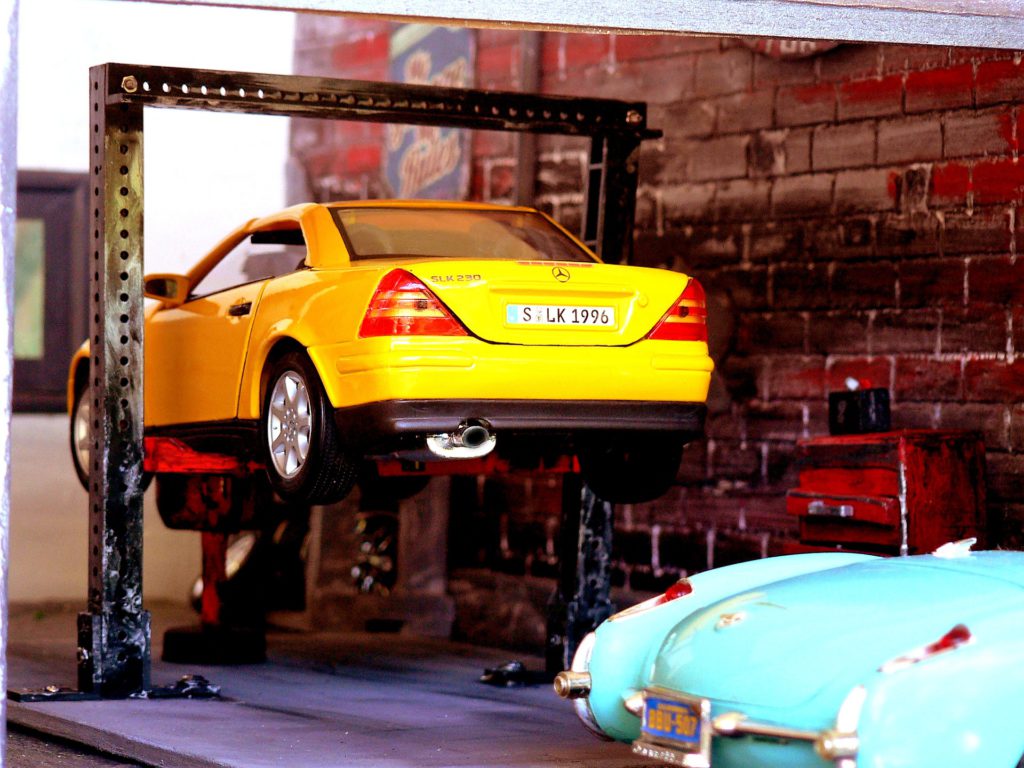The oil change is one of the maintenance items. It’s basic and simple but crucial to prolong the engine life. If you do an oil change yourself, there are many benefits for you. This post shows you how to do an oil change yourself and also benefits when you do it yourself.

Benefits on DIY oil change
- Save you money -If you do the oil change yourself, you don’t have to pay the labor to a mechanic. You will need to buy some tools and equipment, but they cost you only once. After you buy the tools and equipment, all you need to pay for are motor oil and an oil filter. When you go online and search for the oil and filter, you can find ones at deeply discounted prices. For example, 5-quart full synthetic oil costs less than $20 at amazon.com. I have never used this brand of oil before, but according to reviews, it seems OK.
- More cautious to engine condition – If you do the oil change yourself, you will become more perceptive and more understanding of the condition of the engine. Mechanics in a repair shop probably don’t pay much attention to the old oil draining from the oil pan, They throw the old oil to a big container mixing with the old oil from many other customer’s cars. But when you do it yourself, you can examine the old oil thoroughly. Then you can get information like whether or not it was enough oil in the engine, it was dirtier than usual, or there are debris and other particles.
- Other benefits – The reason why an oil change is important is not only benefits directly from the new oil and filter, but also the opportunity to inspect other components of the vehicle. Under the hood, there are many other fluids to check. When the vehicle on the jack, you can check the front end. You can also perform tire rotation by using another jack stand. And then, you can also check the brakes as well. If you think they are too much for you to do, you take your car to a mechanic every two or three times of oil changes.
How to find the right oil and filter
An owner’s manual of your vehicles tells you how much oil and what “weight” you need. Weight actually means thickness or viscosity. It shows like 5W20, 10W30, 20W50, etc. The larger the number, the thicker. Just follow the recommendation on the owner’s manual. However, if your vehicle has a lot of mileage, it may be better to choose a thicker oil than the recommendation.
When you buy oil, I recommend to buy a jug of gallon or 5-quart rather than many 1-quart bottles. The reasons for that is you can use the jug as a container for old oil after you put new oil into the engine. It’s a hassle to divide old oil into many bottles. Old oil has to be recycled. You can take it to gas stations, or parts stores like Pep Boys. They usually take it for free.
To find the right oil filter of your vehicle, in parts stores, there is usually a book to tell you a part number by looking up with your vehicle’s year, make, and model. Or you can just ask a store clerk. If you purchase it online, websites of parts stores automatically show you the right filter of your vehicle after creating an account and entering your vehicle’s year, make and model.
Tools and Equipment needed for an oil change
- Jack – It’s fine to use a scissor or screw jack which is one of original equipment usually found in the truck.
- Jack Stands – Don’t ever use a jack alone. After lifting a car up, you should always put jack stands and sit vehicle’s weight on them for a safety.
- Wheel Chocks – Optional. If you don’t have it, set an emergency brake for a similar advantage.
- Socket Wrench – for loosen and tighten a drain plug. The size is not likely written on the owner’s manual. Neither is it on a repair manual. For the first time of changing the oil, you should bring the whole set of sockets or wrenches. But usually, the size of drain plugs are between 13mm and 19mm. (1/2-inch to 3/4-inch)
- Oil Filter Pliers or Wrench – Metal oil filter can be loosen with the pliers. Paper filters are widely used on European vehicles. They can be accessed by opening a plastic lid. Don’t use pliers, or a plastic lid may get damaged. You should use an appropriate wrench, maybe a socket to open a lid.
- Drain Pan – Choose the size of a drain pan which is more than enough. If it’s just enough, and old oil gets nearly to the edge of a drain pan, it is hard to put it into a container without spilling on the ground.
- Funnel – It’s a must especially when you put oil oil into a container.
- Rubber Gloves – Don’t use cloth or nylon gloves. They are useless when they got oil. For rubber gloves, you can wipe the oil off. You can’t do that on cloth or nylon gloves, and there is a risk getting a burn if you get a hot oil.
- Rugs, Brake Cleaner – For cleaning hands, tools, and so on.
Tips and Tricks on Oil Change
- Find a safe and level ground – Unless you have your own garage, you will have to do an oil change on a driveway or the side of the road. Find a level ground with less traffic, preferably one-way street.
- Warm the engine before draining the oil – Warming the engine warms up the oil as well. That will allow the oil to drain smoothly. You don’t have to warm up too long. A few minutes are enough. If it’s cold weather, it may need a little longer than that.
- Jack up on one side may be enough – Drain plugs are typically located on the lowest point of an oil pan. And many vehicles have a drain plug on the bottom of either side with an angle. So, jacking up on either side will help to drain the oil fast and thoroughly.
- Set an emergency brake – After jacking up, set an emergency brake. It locks the rear wheels.
- Use rubber gloves – You can wipe the oil off of rubber gloves easily. You can’t do that with cloth or nylon gloves. And you may get burned your hands when you have hot oil on cloth or nylon gloves.
- When loosening a drain plug, apply slight pressure to the oil pan – After loosening a drain plug, unscrew it by hand with sightly pressing to the oil pan until you feel it got out of the thread. Make sure of the place of a drain pan while keeping pressing then take a drain plug away. Without pressing it, the oil flows out through the thread. And soon, the drain plug gets too hot to touch.
- Use the same gasket unless it’s damaged – You can re-use the same gasket for a drain plug unless it’s damaged. It fits well most of the times.
- Use a socket wrench only when loosening and tightening a drain plug – After loosening a drain plug, you should unscrew it by hand. When you re-install a drain plug, you should screw it by hand as much as possible then tighten with a socket wrench. This prevents the threads from damaging accidentally.
- Gasket of oil filter is NOT reusable – Use a new gasket with a new oil filter. For metal oil filters, make sure that a gasket of an old oil filter doesn’t stick on the engine block and if there is a gasket on a new oil filter and properly seated. For paper oil filters, a gasket is on a lid. Change it to a new one, which should come with a new oil filter.
- Check the oil level after starting the engine for seconds – Until starting the engine, the oil is not inside of a new oil filter. To make the oil flow to a new filter, you should start the engine until the oil-pressure indicator light goes off. Turn off the engine, and now you can check the correct oil level. Keep in mind that some cars take a little while to stabilize the oil level.
DIY vs. Quick Lube vs. Mechanic Garage

DIY oil charge saves you money the most. Plus, you have free choices on the brand of an oil and filter. Quick Lube shops probably save you time the most. Many shops have cash wash, and you may get a free car wash with an oil change. The drawbacks of quick lube shops are they don’t lift the vehicle. They may check under the hood for you, but not on the front end, suspension, etc. And workers of quick lube shops may not be mechanics. They may not have much knowledge other than an oil change. Mechanic garages, on the other hand, lift the vehicles all the way up. It’s a great opportunity to ask a mechanic to check other components like brakes, front ends, mufflers, etc. But it all depends on garages, personalities of mechanics, and relationship with them. Whichever you end up with, it’s good for you to try to do an oil change yourself once.